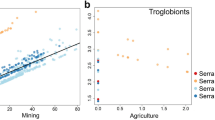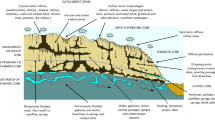Abstract
Variability in landscapes drives patterns in biological communities and is often used to understand biological systems. Rarely, however, have biological systems been used to understand landscape evolution. Here, we review the geomorphic history of cave development in the southern Sierra Nevada Mountains and look at the detail that modern biological systems can add to our understanding of this region's geomorphic history. Cave development has occurred in isolated bands of marble. As water has dissolved rock and downcut through the mountain range, macro-invertebrate communities have colonized these new habitats. Over time, as connectivity patterns have changed between caves, these communities have been isolated from each other. Through looking at similarities and differences between communities, we can delve further into how cave features are connected or have been connected in the past. We calculated Jaccard distance to assess community similarity between caves in the Kaweah River Basin, California. Caves in the same marble band had similar biota, and caves with distinct geomorphic histories had divergent biological communities. This suggests that ecosystems can inform us about the evolution of these landscapes and that this approach may be used to answer other landscape evolution questions.



Similar content being viewed by others
References
Barr TC (1967) Observations on the ecology of caves. Am Nat 101:475–492
Burnham DR, Anderson KP (2002) Avoiding pitfalls when using information-theoretic methods. J Wildl Manag 66(3):912–918
Christman MC, Culver DC (2001) The relationship between cave biodiversity and available habitat. J Biogeogr 28:367–380
Christman MC, Doctor DC, Niemiller ML, Weary DJ, Young JA, Zigler KS, Culver DC (2016) Predicting the occurrence of cave-inhabiting fauna based on features of the earth surface environment. PLoS ONE 11(8):e0160408. https://doi.org/10.1371/journal.pone.0160408
Craw D, Upton P, Burridge CP, Wallis GP, Waters JM (2015) Rapid biological speciation driven by tectonic evolution in New Zealand. Nat Geosci. https://doi.org/10.1038/NGEO2618
Culver DC (2013) Cave life. Harvard University Press, Cambridge. https://doi.org/10.4159/harvard.9780674330214
Culver DC, Christman MC, Elliott WR, Hobbs HH III, Reddell JR (2003) The North American obligate cave fauna: regional patterns. Biodivers Conserv 12:441–468
Danley PD, Husemann M, Ding B, DiPietro LM, Beverly EJ, Peppe DJ (2012) The impact of geologic history and paleoclimate on the diversification of East African cichlids. Int J Evol Biol. https://doi.org/10.1155/2012/574851
Despain JD, Tobin BW, Stock GM (2016) Geomorphology and paleohydrology of Hurricane Crawl Cave, Sequoia National Park, California. J Cave Karst Stud 78(2):72–84. https://doi.org/10.4311/2013ES0114
Despain JD (2006) Hydrochemsitry in an Alpine Karst System, Sequoia and Kings Canyon National Parks, California. M.Sc. thesis, Western Kentucky University
Doctor DH, Alexander EC Jr, Petric M, Kogovsek J, Urbane J, Lojen S, Stichler W (2006) Quantification of karst aquifer discharge components during storm events through end-member mixing analysis using natural chemistry and stable isotopes as tracers. Hydrogeol J 14:1171–1191
Dodson MV, Guan LL, Fernyhough ME, Mir PS, Bucci L, McFarland DC (2010) Perspectives on the formation of an interdisciplinary research team. Biochem Biophys Res Commun 391:1155–1157
Elliott WR (2004) Protecting caves and cave life. In: Culver DC, White WB (eds) Encyclopedia of caves. Elsevier, Amsterdam, pp 458–467
Elliott WR, Reddell JR, Rudolph DC, Graening GO, Briggs TS, Ubick D, Aalbu RL, Krejca J, Taylor SJ (2017) The cave fauna of California. Proc Calif Acad Sci 64(1):1–311
Ford D, Williams P (2007) Karst hydrogeology and geomorphology. Wiley, Chichester, p 562
Fortelius M, Eronen J, Jernvall J, Liu L, Pushkina D, Rinne J, Tesakov A, Vislobokova I, Zhang Z, Zhou L (2002) Fossil mammals resolve regional patterns of Eurasian climate change over 20 million years. Evol Ecol Res 4:1005–1016
Goldscheider N, Meiman J, Pronk M, Smart C (2008) Tracer tests in karst hydrogeology and speleology. Int J Speleol 37(1):27–40
Hess JW, White WB (1988) Storm response of the karstic carbonate aquifer of southcentral Kentucky. J Hydrol 99:235–252
Hoorn C, Wesselingh FP, ter Steege H, Burmudez MA, Mora A, Sevink J, Sanmartin I, Sanchez-Mesegur A, Anderson CL, Figueiredo JP, Jaramillo C, Riff D, Negri FR, Hooghiemstra H, Lundberg J, Stadler T, Sarkinen T, Antonelli A (2010) Amazonia through time: Andean uplift, climate change, landscape evolution, and biodiversity. Science 330(6006):927–931
Jordan S, Hand BK, Hotaling S, Delvecchia AG, Malison R, Nissley C, Luikart G, Stanford JA (2020) Genomic data reveal similar genetic differentiation in aquifer species with different dispersal capabilities and life histories. Biol J Lin Soc 129:315–322
Kahn PJ (2008) Modeling karst development in an alpine location: Mineral King, Sequoia National Park. M.Sc. thesis. California State University, Northridge
Kovarik JL, van Beynen PE (2017) Karst-specific composite model for informed resource management decisions on the Biosfera de la Reserva Selva el Ocote, Chiapas, Mexico. Geol Soc Lond Spec Publ 466:431–442. https://doi.org/10.1144/SP466.1
Krejca JK, Weckerley B (2008) Detection probabilities of karst invertebrates. In: Elliott WR (ed). Eighteenth national cave and karst management symposium (St. Louis, Missouri, USA, 8–12 October 2008, pp 283–289
Krejca J (2006) Inventory of karst fauna in Sequoia, Kings Canyon, and Yosemite National Parks, final report, Contract No. P8558602608. Zara Environmental LLC, Buda (USA)
Luhmann AJ, Covington MD, Alexander SC, Chai SY, Schwartz BF, Groten JT, Alexander EC Jr (2012) Comparing conservative and nonconservative tracers in karst and using them to estimate flow path geometry. J Hydrol 448–449:201–211
Oksanen J, Blanchet FG, Friendly M, Kindt R, Legendre P, McGlinn D, Minchin PR, O’Hara RB, Simpson GL, Solymos P, Stevens MHM, Szoecs E, Wagner H (2019) Vegan: community ecology package. R package version 2.5-6
RStudio Team (2019) RStudio: integrated development for R. RStudio Inc., Boston, Mass. http://www.rstudio.com. Accessed 15 July 2021
Tobin BW, Schwartz BF (2012) Quantifying concentrated and diffuse recharge in two marble karst aquifers: Big Spring and Tufa Spring, Sequoia and Kings Canyon National Parks, California. J Cave Karst Stud 74(2):186–196
Tobin BW, Schwartz BF (2016) Using periodic hydrologic and geochemical sampling with limited continuous monitoring to characterize remote karst aquifers in the Kaweah River Basin, California, USA. Hydrol Process 30(19):3361–3372
Tobin BW, Schwartz BF (2020) Quantifying the role of karstic groundwater in a snowmelt-dominated hydrologic system. Hydrol Process. https://doi.org/10.1002/hyp.13833
Tobin BW, Hutchins BT, Schwartz BF (2013) Spatial and temporal changes in invertebrate assemblage structure from the entrance to deep-cave zone of a temperate marble cave. Int J Speleol 42(2):203–214
Tobin B, Doctor D (2009) Estimating karst conduit length using conductivity and discharge measurements in Lilburn Cave, Kings Canyon National Park, California. In: White WB (ed) Proceedings of the 15th international congress of speleology, vol 3, pp 1702–1706
Acknowledgements
This manuscript was prepared under National Park Service Research Permit Number SEKI-2014-SCI-0013. Spatial data were sourced from Sequoia and Kings Canyon Cave Database and invertebrate data were sourced from Elliott et al. (2017).
Author information
Authors and Affiliations
Corresponding author
Additional information
Publisher's Note
Springer Nature remains neutral with regard to jurisdictional claims in published maps and institutional affiliations.
Rights and permissions
About this article
Cite this article
Sovie, A.R., Tobin, B.W. & Farmer, B. Understanding karst landscape evolution through ecosystems: cave connectivity and isolation. Carbonates Evaporites 37, 8 (2022). https://doi.org/10.1007/s13146-021-00751-4
Accepted:
Published:
DOI: https://doi.org/10.1007/s13146-021-00751-4




